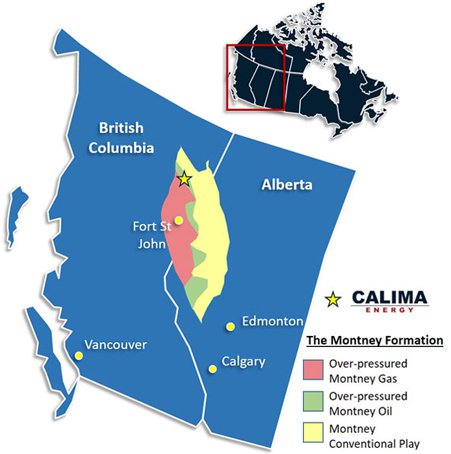Calima Energy provides an update on current production, the status of current field activities, and the expected on-stream dates for the remaining wells in the Pisces and Gemini drilling programs.

Highlights
- Production for February average > 4,200 boe/d
- Brooks Infrastructure Pipeline is progressing ahead of schedule and on budget
- Gemini #6 on production via new Pipeline
- Gemini #5 and Gemini #7 expected to be on production within the next 1-2 weeks
- Pisces #3 has been fracture stimulated and will be flowing back post the next 7-day shut-in period
Production Update
January exit production was 4,300 boe/d and 4 wells are behind pipe waiting to be tiedin prior to 31 March 2022. During February well maintenance activities and pipeline construction resulted in average production above 4,200 boe/d (73% oil).
WTI is presently US$107/bbl with WCS pricing currently at 5-year highs of US$89. Crude oil prices continue to strengthen. Northern American crude oil inventories continued to decline throughout January and February 2022. Over the past 2 weeks, the oil price has continued to increase with Brent at 5 year highs over US$110/bbl. The sanctions against Russia and potentially including oil and natural gas supplies is likely to put further pressure on supply; and result in continued increases to energy prices.
Pipeline Infrastructure at Brooks
Progress on the previously announced pipeline infrastructure at Brooks is ahead of expectations and is nearly complete and is trending to come in on budget. The Pipeline connects the Company’s 02-29 oil battery in the northern portion of the field, to the recently drilled wells (Gemini #5, #6, #7 and Pisces #3) in the southern portion of the field and most importantly, will provide egress for planned production growth in the pipeline corridor located in the heart of the Brooks properties. Exceptional construction efficiencies have been achieved through detailed project management by our engineering team, construction crews and field staff.
Gemini #5 and #6 has been completed and both wells are now tied into the pipeline.
The Gemini #7 will be tied-in within 7 days. Pisces #3 will be tied in and brought on production by mid-March.
The final section of the pipeline which connects existing producing wells in an area that currently has fluid volumes trucked to 02-29 battery, will be connected, and flowing into the battery by the end of March. The Pipeline will significantly reduce operating costs, as well as adds several significant ESG benefits, including the elimination of flaring of new wells during initial production testing. Most importantly, it will eliminate trucked volumes of emulsion from existing, newly drilled, and future wells that are or will be connected to the 2-29 battery via the new Pipeline. Reducing trucking improves the Company’s safety and spill prevention profile and ESG score.
J2J Waterflood
The Countess Sunburst J2J Pool at Brooks was discovered in 2003 and initially developed using vertical wells. Horizontal drilling was introduced in the pool in 2014 which improved production rates and primary recoveries with strategically placed horizontal well legs throughout the reservoir.
A pilot waterflood and full battery buildout was completed in Q1 2020. Based on the initial results of the pilot, waterflood expansion was planned in 2022 with the goal of field wide waterflood development in 2023.
The Company has been pleased to note that the initial stage of the CountessJ2J waterflood pilot has begun to show positive response in the producing wells. Increased inflow in existing producing horizontal wells indicates that the waterflood is working, and this initial waterflood response is in line with reservoir modelling, and waterflood simulation performed prior to implementation of the pilot waterflood.
The next stage for the waterflood includes converting two existing vertical wells into water injectors and converting an existing vertical well into a water source well, increasing the quantum and areal extent of water being injected in the Pool.
This is expected to increase the waterflood response in the Pool, resulting in increased reserves, shallower decline, and ultimately an increase in oil production.
Ultimate primary recovery factor for the Pool before any waterflood implementation is estimated at 14% of the oil in place, and the current recovery factor to date from the existing wells is estimated at 8%. Analogous Sunburst Formation pools under secondary recovery (waterflood) in the area, have achieved recovery factors of 25% or higher. Every 1% increase in recovery factor of the estimated 15mmbbl of oil in place in the J2J Pool, results in another 150mbbl of incremental recoverable reserves for the Company.
Jordan Kevol, CEO and President:
We are very pleased with progress in the field at Brooks. Kudos to the related staff and contractors who have worked very diligently to achieve such progress, and to the team who have put the planning together over the past 12 months. Before the winter frost melts, the team is focused on the Bantry Field at Brooks to equip and tie-in the four wells currently behind pipe (Gemini and Pisces). We are ahead of our goal of having Gemini #5, #6, #7, and Pisces #3 on production by the end of March which will positively contribute to current cash flow and our H1 2022 average production of 4,000-5,000 boe/d”
KeyFacts Energy: Calima Energy Canada Onshore country profile
 KEYFACT Energy
KEYFACT Energy